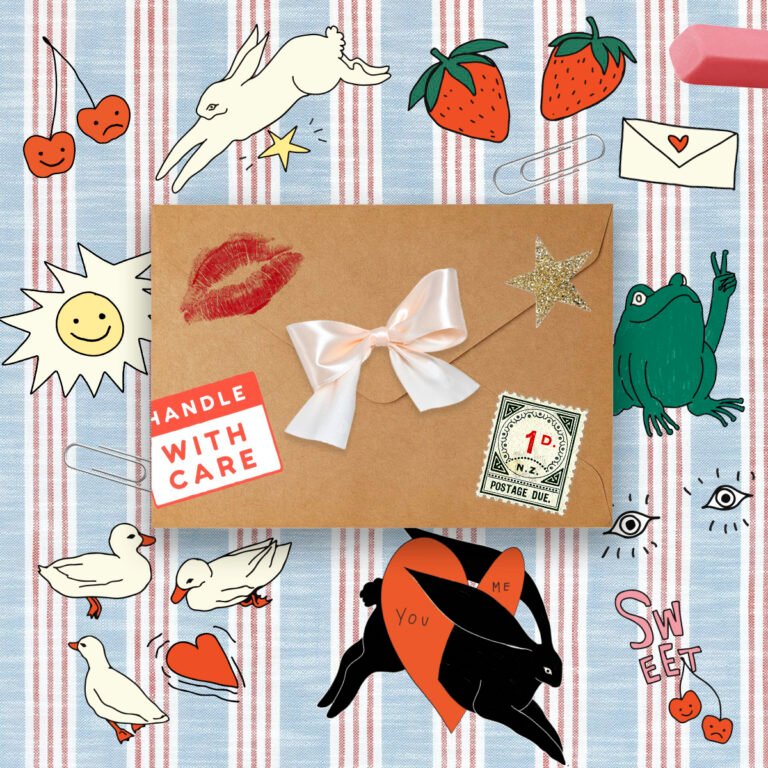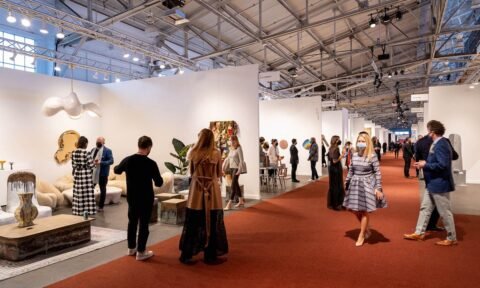In mail art, the canvas is a postcard or a piece of paper in an envelope. Mail art highlights process and experience in addition to the product itself. It encompasses creation (writing, composition, choice of multimedia, paper, postal stamp, and envelope); transportation (the walk to the mailbox, the postal journey, physical additions by the mail service, delivery); and reception (retrieving, opening, enjoying). Mail art is both affordable and egalitarian, not requiring the approval of galleries or museums; the only barrier for display is the cost of a stamp. Right now, when our mailboxes are mostly full of bills and advertisements, receiving mail art feels particularly special.
Though artistically driven communication has existed as long as communication itself, Ray Johnson is considered to be the leading figure in the mail art movement. Johnson incorporated collage, (rabbit-heavy) illustration, and experimental layout into a global mail art network. Drawing on “a blyth spectrum of Americana, gossip, and mass communications,” as Lawrence Alloway put it in Art Journal’s 1977 collaborative report on mail art, Johnson’s work was distinct when he began in the 1940s and remains so today. A terminology to describe mail art approach wasn’t created until the early 1960s, when fellow mail artist Edward Plunkett named the growing network the New York Correspondence School. This was a tongue-in-cheek nod toward the concurrent abstract expressionism movement, also referred to as the New York School. Plunkett opulently described the art of correspondence as “an ephemeral, evanescent business,” which makes it “possible to communicate with someone on one level without knowing them on any other.” In 2021, the Art Institute featured Johnson’s mail art in an exhibition after acquiring a large archive of his work a few years prior.
Chicago’s role in the contemporary mail art ecosystem mainly began in the 1990s, and has ebbed and flowed since. Ashley Parker Owens ran the mail art magazine Global Mail, hosting an open call mail art show at ARC Gallery in 1993, and writing in a 1995 interview with Ruud Janssen, “It is important not to make this a secret club. There’s plenty of stamps for everyone.” Dorothy Patrick Harris, who used the moniker arto posto, also practiced mail art in Chicago in the 1990s, with a focus on rubber stamps and artistamps (artist-made pseudostamps). Starting in 1994, Michael Hernandez de Luna and Michael Thompson began a decades-long project of sending mail with politically charged artistamps, with the goal of them being returned to sender. From 2018–2020, the late Jason Pickleman hosted open call mail art shows at Lawrence & Clark, his noncommercial gallery. These ran annually, with the gallery’s mailman choosing the “best in show.”

Courtesy Starshaped Press
The year 2020 spurred a resurgence of mail art (and mailed art) due to the isolation of COVID-19 and as a widespread response to the United States Postal Service (USPS) crisis created by then Postmaster General Louis DeJoy. Exhibitions dedicated to mail art popped up around Chicago, such as “Hello USPS” by Purple Window Gallery and “Art in the Post” at the Elmhurst Art Museum. Motivated by a variety of factors—desire for creative structure, love for mail and tangible art objects, sudden need to stay financially afloat by alternative methods—artists and print studios started mail clubs. Five years later, the mail clubs remain. Many intend to continue indefinitely.
Starshaped Press | Print Club
starshaped.com/print-club-listings
Derek Erdman | Friend Club
derekerdman.com/free.htm
Sunroom | Monthly Flyer Club
hellosunroom.com/shop/monthly-flyer-club
Hannah Sellers | Catdroool Club
catdroool.com/club
Elena Gatti | Fiorenza Friends Club
fiorenzaart.com/products/fiorenza-friends-club
Starshaped Press, founded by Jen Farrell, has operated as a letterpress studio in Ravenswood for more than 25 years. In September of 2020, Farrell started a multitiered monthly Print Club as a way to financially bridge the gap during what would usually be their busiest season. Print Club tiers range from a letterpress postcard mailed in an envelope to a packaged postcard, greeting card, print, and miscellaneous stationery. Constructed of vintage ornaments and type, these items are intended to be multipurpose. “I try to focus on the things that unite people,” she explained. “What can we all get behind? What themes are popular with people who care about letterpress?” Farrell’s goal with the tiered membership model was to have a low entry point (the lowest is $5 per month). What she found, however, was that people were eager to support the shop, with the most expensive membership tier ($27) being the most popular.
Almost five years later, Starshaped’s mail club remains a large source of income for the shop. “I did not see it coming,” Farrell said, “that it would grow in popularity and become a big money generator for the studio.” There are currently around 250 Print Club members across all levels, mostly made up of “book nerds and librarians,” according to Farrell. “I don’t design things that are popular in the real world. It’s for a very niche crowd. So I hope the print club continues.”
Derek Erdman’s Friend Club runs on a different model: it is free to join but involves a tedious enrollment process. “There was a time when I would get a dozen [applications] a day, so I really had to slow it down,” Erdman explained. “I’d say, ‘Oh, it’s closed this month, but if you call at 3 PM on Tuesday . . . ’ But people would actually do it.”

Credit: Shira Friedman-Parks
As of right now, to join the Friend Club, prospective members have to mail Erdman an application listing their name, address, favorite thing, and worst fear. Members then receive a numbered, laminated membership card. Within the Friend Club, there is a subsection of members who opt in to mail correspondence with Erdman. (There are currently around 2,350 card-carrying Friend Club members; around 800 of them have opted in to receiving mail.) On Erdman’s end, this involves sending out prints, mazes, interactive surveys, postcards, and other objects he finds interesting. While belonging to the mail club is free, members often reciprocate by sending mail to Erdman in return. “I love getting mail,” Erdman explained. “I have dozens and dozens of pen pals. We trade postcards, even simple things, through mail. One guy just sent me a package of oatmeal today in the mail. It was just a stamp on a package of instant oatmeal with my address. I love coming home to a bunch of mail. I guess it’s the golden rule: treat others how you’d like to be treated.”
Erdman started Friend Club in 2020, inspired by and in honor of his friend, the late Jason Polan, who had hosted the Taco Bell Drawing Club. Friend Club began as a way to thank people who financially supported his art in other ways: “It’s really kind for people to buy things. What can I do for them? Here’s something in the mail because we’re separated.” Friend Club does not follow a regular schedule—“There’s certainly no rhyme or reason for what happens,” Erdman noted—but that’s not to say he doesn’t approach it with thought and care. “I now view the world with what I can give to people in the Friend Club. If I go to a thrift store and find things I could send to Friend Club members, I buy them.”
Sunroom, a risograph studio and label run by Clare Byrne and Jacob Stolz, began its Monthly Flyer Club in May of 2021. Of the five mail clubs I spoke to, Sunroom has the largest membership.
Sunroom’s 8.5 by 11 inch flyers alternate stylistically between photography and collage, and are consistently inspired by nature, seasonal changes, and their love for physical media. “I would call us collectors,” Byrne said. “We collect a lot of vintage magazines, records, and vintage art books. We flip through those all the time.” Their collecting is not specific to artifacts of the past: “Sometimes it’s as simple as picking up leaves in the neighborhood,” Stolz added.
Similar to other mail clubs, Sunroom’s Monthly Flyer Club was a response to a combination of situational factors. “It crossed off a lot of things for us: a) it supported the post office, b) we were able to connect offline with people during the pandemic, and then c) as artists, it was a great way for us to keep up a consistent practice with built-in deadlines,” Byrne said. But it stuck: “We just loved it. We’ve been doing it for four years now. . . . It’s starting to feel like a visual diary for us.” Byrne and Stolz plan to continue the Monthly Flyer Club “in its exact form for as long as possible.”
Hannah Sellers, a “jack-of-all-trades” freelance designer and cofounder of the community art space Lot’sa, founded the monthly Catdroool Club in 2021. The club began with ten members and utilizes a variety of print mediums as a way for Sellers to set aside time for her own creative practice. “It was really sweet,” she said, “and it still is really sweet.” Since then, the club has grown to encompass 400 members, which Sellers attributes to a shared desire to interact with the physical world. “That’s where a lot of my inspiration comes [from], and I think that’s why a lot of people join any of these mail clubs. It’s to have something to hold onto that’s real.”

Courtesy Catdroool
To accommodate this growth in membership, Sellers brought on a friend to help run the back end. She now exclusively uses a risograph for her prints, after co-acquiring one for Lot’sa. While Sellers does not want to grow Catdroool Club infinitely (“We all have this growth mindset in capitalism: grow, grow, grow, grow, and to what end?”), her penultimate goal is to be able to employ someone full-time (“for a job in art!”). Until then, she plans to continue “speaking to Chicago with my mail club.”
Most recently, in 2024, Elena Fiorenza Gatti started Fiorenza Friends Club, a monthly mail club inspired by junk journaling—the practice of memory-collecting through scrapbooking tangible items. Each month, members get some combination of a mini print, a sticker sheet, a “love letter” (assorted handwritten ramblings), and a bookmark. “I use it as a way to highlight what I’m really into that month,” Gatti explained. “What I’m exploring in my art, whether that’s a new subject matter, a new message, or a new technique. It reflects what I’m doing in real time, which I think is fun.”
She is primarily inspired by other junk journalers such as Martina Calvi (“who started the junk journal renaissance”) and Kalli (“the junk journal queen of Chicago”). Fiorenza Friends Club currently has 800 members, with a waitlist of 600. Each month, 20–50 slots open up. While Gatti enjoys the opportunity to connect with her audience, the ability to distribute her work at a lower price point, and the financial cushion during slow seasons, she worries the mail club takes too much time away from her main art practice. “This could be a main source of income if someone was really serious with it,” she said, “but I definitely don’t want to keep doing this. That would scare me. I want to keep painting.”
A central debate within mail art and mail clubs is whether or not to charge money. For some, the appeal of mail art is the lack of transaction. Arto posto, in her 1995 interview with Ruud Janssen, wrote: “Each person will handle her participation in the movement in her own way, and that is as it should be, in my opinion. . . . I like it that mail art really does not have hard and fast ‘rules.’ . . . Personally I like to stick with the ‘no money exchanges hands.’ . . . I can certainly understand that there are practical reasons WHY it occurs. It’s just not a part of the movement that appeals to me, nor one I personally care to get involved with.”
Erdman noted that his Friend Club is “certainly no way to make money. It’s only losing money.” But for others, mail clubs provide anywhere from a financial safety net to significant financial support. Gatti argued that “it is so important for artists to monetize what they have. We sometimes feel guilty about that, but it’s so hard to make a living just selling original art pieces. That’s not feasible nowadays.” Similarly, Sellers sees mail clubs as a new pathway for artists to support themselves: “I hope the phrase ‘mail club’ becomes more ubiquitous. I hope that other full-time artists can be inspired to start their own mail club.” Starshaped’s Print Club has become an integral source of income for the studio.

Courtesy Sunroom
“It’s always kind of scary, just dropping it off, hoping it arrives,” said Stolz of Sunroom. Relying on the postal service inherently causes mishaps, such as lost and damaged packages, or items returned to the sender. “There’s a point where it is truly out of your hands,” Byrne of Sunroom added. Farrell always prints extra items, both to sell on their own and to accommodate losses: “Maybe every other month, something’s gone missing or is just completely destroyed by a mail truck.” Nonetheless, people who run mail clubs tend to care for USPS and become close with the people who work there. Gatti said her local post office’s employees call her when new stamps come in. Erdman does one better. “I’m really good friends with all the people at the post office,” he told me, “so that’s awesome. They just wave me through. A lot of people hate the post office. I understand it’s very frustrating. The lines are terrible. But if you have your shit together and you bring them apples, which is what I do, they really learn to love you.”
Above all else, mail is an interactive experience, rooted in an affection for the tangible. “Part of the art piece is the experience of physically opening it, taking it out of your mailbox, seeing the stamp on the outside of it,” Byrne said. This level of interactivity was valued by all of the mail clubs I spoke with. Some take it a step further: Sellers of Catdroool occasionally sends out interactive prints, such as last February’s Valentine’s Day–inspired Mad-Lib love letter, or a build-your-own-picnic, with one print as the picnic blanket and a second with items to place on top. Erdman’s Friend Club members recently received an in-depth personality assessment made in conjunction with a University of Chicago student. “It was a little ridiculous, but it was actually scientific,” he assured me.
Interactivity in mail art dates back to Ray Johnson himself, whose mail art works would often include fill-in-the-blanks or requested actions on the receiver’s part. Despite the inconveniences, mail clubs offer a connection that goes beyond the mailed object. “There’s a lot to be really angry about right now,” Sellers remarked. “You don’t have to look far to find pain. To send people an envelope with something joyful in it that’s not an advertisement—it doesn’t get better than that.”




